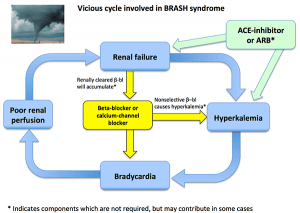Brash syndrome
Background

via emcrit.org
- Combination of:
- Renal failure
- AV node blocker: beta-blocker, verapamil or diltiazem- typically adherent with medication but an overdose
- Shock
- Hyperkalemia
- Bradycardia
- Vicious cycle: in setting of medications, hyperkalemia, renal failure
- Renal failure causes hyperkalemia (+/- accumulation of AV node blockers), hyperkalemia synergizes with AV node blockers to cause bradycardia and hypoperfusion, hypoperfusion worsens renal failure [1]
Clinical Features
- Asymptomatic or symptomatic bradycardia
- Typically appear more well than vitals/labs suggest
- Multisystem organ failure (shock, pulmonary edema, renal failure, shock liver)
- Altered mental status
Differential Diagnosis
Symptomatic bradycardia
- Cardiac
- Inferior MI (involving RCA)
- Sick sinus syndrome
- Neurocardiogenic/reflex-mediated
- Increased ICP
- Vasovagal reflex
- Hypersensitive carotid sinus syndrome
- Intra-abdominal hemorrhage (i.e. ruptured ectopic)
- Metabolic/endocrine/environmental
- Hyperkalemia
- Hypothermia (Osborn waves on ECG)
- Hypothyroidism
- Hypoglycemia (neonates)
- Toxicologic
- Infectious/Postinfectious
- Other
Evaluation
- May have only mild hyperkalemia, with bradycardia out of proportion to degree of hyperK
- EKG: may mot have typical findings of hyperkalemia
Management
- Hyperkalemia treatment (e.g. IV insulin/dextrose, albuterol, IV calcium, kaliuresis or dialysis)
- IVF resuscitation for hypovolemia
- Catecholamines (e.g. epinepherine) for persistent bradycardia/shock
- Consider isoproterenol
- Targeted treatments for beta-blocker or CCB overdose not helpful
- May not respond well to atropine or transcutaneous pacing
- Aggressive early diuresis
Disposition
- Admit, typically to ICU setting
See Also
- Renal failure
- Pure hyperkalemia
- Pure AV node blocker intoxication (e.g. calcium channel blocker toxicity, beta-blocker toxicity)
External Links
References
- Hegazi MO, et al. Junctional bradycardia with verapamil in renal failure--care required even with mild hyperkalemia. J Clin PHarm Ther. 2012;37(6):726-8.
This article is issued from
Wikem.
The text is licensed under Creative
Commons - Attribution - Sharealike.
Additional terms may apply for the media files.